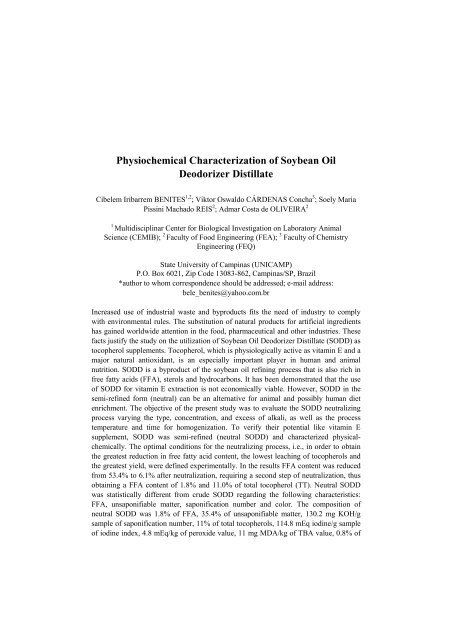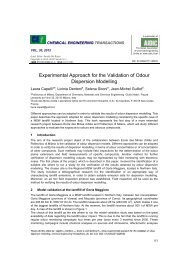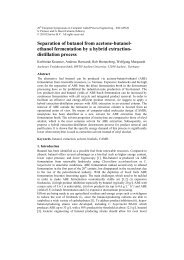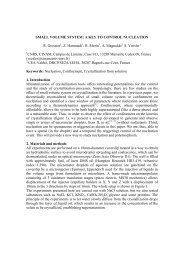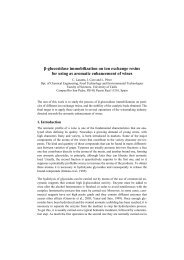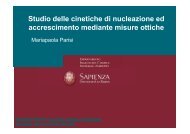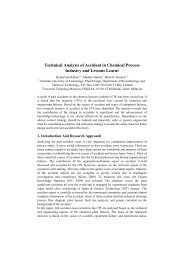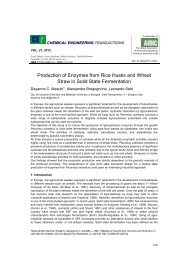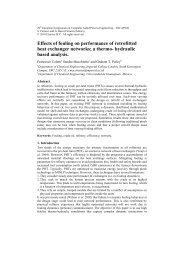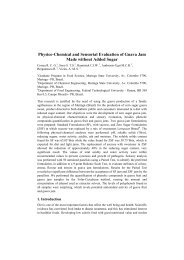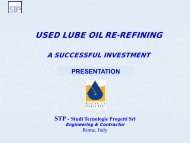Physiochemical Characterization of Soybean Oil Deodorizer ... - Aidic
Physiochemical Characterization of Soybean Oil Deodorizer ... - Aidic
Physiochemical Characterization of Soybean Oil Deodorizer ... - Aidic
You also want an ePaper? Increase the reach of your titles
YUMPU automatically turns print PDFs into web optimized ePapers that Google loves.
<strong>Physiochemical</strong> <strong>Characterization</strong> <strong>of</strong> <strong>Soybean</strong> <strong>Oil</strong><br />
<strong>Deodorizer</strong> Distillate<br />
Cibelem Iribarrem BENITES 1,2 ; Viktor Oswaldo CÁRDENAS Concha 3 ; Soely Maria<br />
Pissini Machado REIS 2 ; Admar Costa de OLIVEIRA 2<br />
1 Multidisciplinar Center for Biological Investigation on Laboratory Animal<br />
Science (CEMIB); 2 Faculty <strong>of</strong> Food Engineering (FEA); 3 Faculty <strong>of</strong> Chemistry<br />
Engineering (FEQ)<br />
State University <strong>of</strong> Campinas (UNICAMP)<br />
P.O. Box 6021, Zip Code 13083-862, Campinas/SP, Brazil<br />
*author to whom correspondence should be addressed; e-mail address:<br />
bele_benites@yahoo.com.br<br />
Increased use <strong>of</strong> industrial waste and byproducts fits the need <strong>of</strong> industry to comply<br />
with environmental rules. The substitution <strong>of</strong> natural products for artificial ingredients<br />
has gained worldwide attention in the food, pharmaceutical and other industries. These<br />
facts justify the study on the utilization <strong>of</strong> <strong>Soybean</strong> <strong>Oil</strong> <strong>Deodorizer</strong> Distillate (SODD) as<br />
tocopherol supplements. Tocopherol, which is physiologically active as vitamin E and a<br />
major natural antioxidant, is an especially important player in human and animal<br />
nutrition. SODD is a byproduct <strong>of</strong> the soybean oil refining process that is also rich in<br />
free fatty acids (FFA), sterols and hydrocarbons. It has been demonstrated that the use<br />
<strong>of</strong> SODD for vitamin E extraction is not economically viable. However, SODD in the<br />
semi-refined form (neutral) can be an alternative for animal and possibly human diet<br />
enrichment. The objective <strong>of</strong> the present study was to evaluate the SODD neutralizing<br />
process varying the type, concentration, and excess <strong>of</strong> alkali, as well as the process<br />
temperature and time for homogenization. To verify their potential like vitamin E<br />
supplement, SODD was semi-refined (neutral SODD) and characterized physicalchemically.<br />
The optimal conditions for the neutralizing process, i.e., in order to obtain<br />
the greatest reduction in free fatty acid content, the lowest leaching <strong>of</strong> tocopherols and<br />
the greatest yield, were defined experimentally. In the results FFA content was reduced<br />
from 53.4% to 6.1% after neutralization, requiring a second step <strong>of</strong> neutralization, thus<br />
obtaining a FFA content <strong>of</strong> 1.8% and 11.0% <strong>of</strong> total tocopherol (TT). Neutral SODD<br />
was statistically different from crude SODD regarding the following characteristics:<br />
FFA, unsaponifiable matter, saponification number and color. The composition <strong>of</strong><br />
neutral SODD was 1.8% <strong>of</strong> FFA, 35.4% <strong>of</strong> unsaponifiable matter, 130.2 mg KOH/g<br />
sample <strong>of</strong> saponification number, 11% <strong>of</strong> total tocopherols, 114.8 mEq iodine/g sample<br />
<strong>of</strong> iodine index, 4.8 mEq/kg <strong>of</strong> peroxide value, 11 mg MDA/kg <strong>of</strong> TBA value, 0.8% <strong>of</strong>
moisture, 9.7 kcal/g <strong>of</strong> energetic value and 0.906 g/mL <strong>of</strong> liter weight. These results<br />
suggest the potential use <strong>of</strong> SODD as a supplement.<br />
1. Introduction<br />
Deodorization is a step <strong>of</strong> soybean oil refine, that removes volatile compounds<br />
responsible for oil undesirable taste, producing <strong>Soybean</strong> <strong>Oil</strong> <strong>Deodorizer</strong> Distillate<br />
(SODD) like a byproduct. However, this process also removes tocopherols, making<br />
SODD a precious byproduct and its price depends on their tocopherol contents (Borher<br />
et al., 2002). Brazil is the second largest soybean producer and therefore has a big<br />
amount <strong>of</strong> byproduct, prevailing to tocopherols recovery (Martins et al., 2006a).<br />
Chemically, SOOD is a complex mixture <strong>of</strong> free fatty acids (FFA), triglycerols, cetones,<br />
peroxides, hydrocarbons, oleins, sterols and tocopherols. A high concentration <strong>of</strong> FFA<br />
can be harmful to health, because its accumulation promotes apoptosis, i. e., leading to<br />
cellular death (Okoshi et al., 2007). Therefore, neutralization step is enough to use<br />
SODD like as a tocopherol supplement.<br />
SODD has gained increased attention due to exportation, mainly to countries that obtain<br />
tocopherol concentrates to use in food and pharmaceuticals industries as natural<br />
antioxidants (De Greyt and Kellens, 2000). These concentrates require many techniques<br />
to be obtained, making the product expensive.<br />
Tocopherols are compounds with vitamin E activity and are important antioxidants,<br />
protecting unsaturated lipids in cellular membranes against oxidation (Benites et al.,<br />
2005).<br />
Nowadays there is a need to study alternative sources <strong>of</strong> tocopherols, such as from<br />
SODD, which could be used as a supplement without increasing final product costs.<br />
Vitamin E, present in SODD, was effective in protecting against lipids oxidation in rats<br />
liver, and showed no toxicity to animals. However, the results <strong>of</strong> lipid oxidation were<br />
higher than those obtained with supplementation <strong>of</strong> synthetic vitamin E (Moraes et al.,<br />
2004).<br />
Therefore, given the importance <strong>of</strong> tocopherols, the use <strong>of</strong> SODD in the most crude<br />
form, non-toxic, can be a solution for a viable vitamin supplement. The use <strong>of</strong> this<br />
product as a nutrient in the diet also corroborates with the increase in the worldwide<br />
trend <strong>of</strong> using natural ingredients and compounds. Besides the economic aspect,<br />
researches with this product have been increasing, looking for methods to employ the<br />
SODD (Borher et al., 2002; Moraes et al., 2004), and studying possible SODD toxic<br />
effects in the body (Oliveira et al., 2005; Oliveira et al., 2006).<br />
This work aims to characterize the crude and neutral SODD chemically, mainly as:<br />
composition <strong>of</strong> fatty acids, free fatty acids, levels <strong>of</strong> total tocopherols and their isomers,<br />
verifying its potential as a vitamin E supplement.<br />
2. Materials and methods<br />
SODD from the Cargill Agrícola S.A. industry (Mairinque, Brazil) was<br />
stequiometrically neutralized, considering an excess <strong>of</strong> 20% (Bhattacharyya &<br />
Bhattacharyya, 1987). Neutralization conditions were determined according<br />
methodology describes by Benites et al. (2005), with the parameters: Na2CO3 4.34N,
temperature 45.8°C and homogeneization time <strong>of</strong> 3’20”. Both crude SODD and neutral<br />
SODD were characterized by:<br />
- Tocopherol content: The analysis was carried out according to HPLC Ce 8-89 method<br />
(AOCS, 1998), using an isocratic pump Perkin Elmer 250 and fluorescence detector<br />
Shimadzu RF-10 AXL, which was set at: excitement - 290nm; emission - 330nm. The<br />
tocopherol separation was carried out on MERCK Li Chrosorb Si 60 column (250 x 4<br />
mm) using as mobile phase 99:1 Hexane/Isopropanol at 1.1 mL/min and room<br />
temperature. The isomers were identified by retention time, co-chromatography and<br />
UV-Vis absorption spectrum as compared to standards (α, β, γ and δ-tocopherol,<br />
Calbiochem purity ≥ 95%) analyzed in the same conditions. The quantification was<br />
carried out by external calibration curves for α, β, γ and δ-tocopherol;<br />
- Fatty acid composition: The FA were extracted according to the methylic esters<br />
method (Hartman & Lago, 1973), and were analyzed according to the Ce 1-62 injection<br />
method (AOCS, 1998). The gas-chromatograph used was a CGC AGILENT 6850<br />
SERIES GC SYSTEM, with capillary column: DB-23 AGILENT (50% cyanopropyl –<br />
methylpolysiloxane, 60m x 0.25 mm internal diameter, 0.25 µm film thickness). The<br />
chromatographic conditions were: flow <strong>of</strong> 1.0 mL/minute; linear speed <strong>of</strong> 24 cm/seg;<br />
detector temperature <strong>of</strong> 280°C; injector temperature <strong>of</strong> 250°C; volume injected <strong>of</strong> 1μL;<br />
and Helium as carrier gas. The oven temperature programme was set as follows: 110°C<br />
(5 min), 110-215°C (5°C/min), 215°C (24 min). The fatty acids were identified by<br />
retention time as compared to a standard mixture analyzed in the same conditions;<br />
- Free Fatty Acids (FFA): 940.28 (AOAC, 1995); Peroxide value: 965.33 (AOAC,<br />
1995);<br />
- TBA value: method described by Sinnhuber & Yu (1958);<br />
- Iodine index: Hanus - 920.158 (AOAC, 1995);<br />
- Saponification number: 920.160 (AOAC, 1995);<br />
- Moisture content: Karl Fischer Tb 2-64 (AOCS, 1998);<br />
- Unsaponifiable matter: Ca 6b-53 (AOCS, 1998);<br />
- Energetic value: Measure made in automatic calorimeter (PARR 1261) with oxygen<br />
pump (PARR 1108);<br />
- Determination <strong>of</strong> mass per unit volume (liter weight): Cc 10c-95 (AOCS, 1998);<br />
- Color: the instrumental analysis was evaluated by total transmittance, through Hunter<br />
Lab colorimeter (Color Quest model), method CIELAB L*a*b* in universal program,<br />
using the parameters: 10° visual angle, lighting D 65, luminosity (L*, 100-white 0black),<br />
red index (a* - red/green) and yellow index (b* - yellow/blue).<br />
The data were collected and the averages compared by t student test (P≤0.05) using the<br />
s<strong>of</strong>tware STATISTICA 7.0 ® .<br />
3. Results and discussion<br />
In relation to fatty acid (FA) composition, the main were palmitic<br />
(17.7,14.5,12.7 and 11.4%), oleic (23.3, 24.0, 26.4 and 24.2%) and<br />
linoleic (43.3, 47.5, 50.5 and 51.4%) for crude SODD, neutral SODD,<br />
synthetic vitamin E and soybean oil, respectively. According to Almeida et<br />
al (2003), crude SODD had 17.7% <strong>of</strong> palmitic, 23.3% <strong>of</strong> oleic and 43.3% <strong>of</strong><br />
linoleic fatty acids. Augusto (1988) corroborates these data, obtaining as
main FA in the crude SODD: palmitic 23.1%, oleic 19.5% and linoleic 48.5%.<br />
For soybean oil, these values were 10.9, 21.8 and 57.1%, respectively.<br />
The main physical and chemical characteristics <strong>of</strong> crude and neutral SODD samples are<br />
described in Table 1. Crude SODD had FFA <strong>of</strong> 53.8% (±0.5) and after neutralization,<br />
the FFA content was 1.8% (±0.1). So, the neutral SODD had its FFA content reduced in<br />
96.7%. The SODD used by Martins et al. (2006b), had 57.8% <strong>of</strong> FFA content.<br />
According to Augusto (1988) the crude SODD characterization showed <strong>of</strong> FFA 37.1%.<br />
In another work, Almeida et al. (2003) determined the mass per volume, saponification<br />
number and evaporation residue, being the first two analyses similar to the values found<br />
in the present work, but the moisture content was higher, possibly due to differences in<br />
method <strong>of</strong> analysis. The energetic value <strong>of</strong> SODD, measured by calorimetric pump, is<br />
coherent with oil products (9.5 and 9.7 kcal / g for crude and neutral SODD,<br />
respectively).<br />
The oxidation rate <strong>of</strong> neutral SODD was reduced 36% for peroxides and 31.3% for<br />
TBA comparing to crude SODD, i.e., these oxidation products have been partially<br />
separated during the neutralization process. In literature, reference values for these rates<br />
have not been found, since depends on storage quality <strong>of</strong> the product.<br />
As regards to the unsaponifiable matter content, Almeida et al. (2003) found a wide<br />
range <strong>of</strong> values (3.5 - 27.1%) for different SODD samples. In this work, this content<br />
was 20.1% (crude SODD), resulting in a higher tocopherols content (10.4%), since<br />
tocopherols are part <strong>of</strong> the unsaponifiable matter. Almeida et al. (2003) determined<br />
8.6% <strong>of</strong> tocopherol for the sample with the highest unsaponifiable matter content<br />
(27.1%).<br />
Table 1. <strong>Physiochemical</strong> characterization <strong>of</strong> crude and neutral<br />
Analyses *<br />
SODD<br />
Crude Neutral<br />
FFA (%) 53.8 a (±0.5) 1.8 b (±0.1)<br />
Mass per volume 0.906 (±0.002) 0.906 (±0.001)<br />
Saponification number (mg KOH/g sample) 159.4 a (±3.7) 130.2 b (±4.6)<br />
Moisture (%) 0.8 (±0.1) 0.8 (±0.1)<br />
Energetic value (kcal/g) 9.5 (±0.01) 9.7 (±0.1)<br />
Peroxide value (mEq/kg) 7.5 (±2.7) 4.8 (±0.9)<br />
TBA value (mg MDA/kg) 16.0 (±4.2) 11.0 (±3.5)<br />
Iodine Index (mEq Iodo/g sample) 109.6 (±1.8) 114.8 (±4.2)<br />
Color L* 52.46 a (±0.04) 18.65 b (±0.39)<br />
a* 31.10 b (±0.05) 33.94 a (±0.34)<br />
b* 77.43 a (±0.05) 29.67 b (±0.71)<br />
Unsaponifiable matter (%) 20.1 b (±0.1) 35.4 a (±1.0)<br />
* Mean values (± standard deviation)<br />
Different letters in the same column indicate statistical difference (t student P
(2006b), had lower total tocopherol content (9.0%), differing in the isomers ratio α-T<br />
(2.9%), β-T (0.1%), γ-T (4.7%) e δ-T (1.3%).<br />
The tocopherols content is an important aspect to consider the use <strong>of</strong> SODD as<br />
supplement. Studying the application <strong>of</strong> intraruminal SODD in Nelore steer and<br />
evaluation <strong>of</strong> the absorption and incorporation <strong>of</strong> vitamin E in different tissues, Borher<br />
et al. (2002) found an increase in the vitamin E concentration in the liver, muscle and fat<br />
in their coverage, and better stability <strong>of</strong> the color <strong>of</strong> meat and increased oxidative<br />
stability <strong>of</strong> fat. Thus, the use <strong>of</strong> SODD in nature (crude) seems to be a low cost and<br />
efficient alternative for the incorporation <strong>of</strong> tocopherols in tissues and animals, bringing<br />
benefits to meat consumers.<br />
Table 2. Mean values <strong>of</strong> tocopherol content (%) in crude and neutral SODD, synthetic<br />
vitamin E and soybean oil<br />
Sample Isomers (%) Total<br />
α-T β-T γ-T δ-T Tocopherol (%)<br />
Crude SODD 1.28 0.22 6.59 2.36 10.44<br />
(± 0.02) (± 0.01) (± 0.03) (± 0.04)<br />
Neutral SODD 2.03 0.25 6.67 2.03 10.98<br />
(± 0.04) (± 0.01) (± 0.28) (± 0.08)<br />
Synthetic vit. E 3.75<br />
(± 0.05)<br />
- - - 3.75<br />
<strong>Soybean</strong> oil 0.02 0.002 0.07 0.01 0.10<br />
(± 0.001) (± 0.00) (± 0.006) (± 0.001)<br />
Mean values (± standard deviation)<br />
The neutralization process revealed to be an adequate method to allow the use <strong>of</strong><br />
SODD, since FFA are harmful to cells and the tocopherols are difficult to extract.<br />
In order to study an industrial by-product as a natural tocopherols source (vitamin E),<br />
the neutral SODD presented low cost, simple method <strong>of</strong> production and potential use as<br />
a supplement.<br />
References<br />
A.O.A.C. Official methods <strong>of</strong> analysis <strong>of</strong> Association <strong>of</strong> Official Analytical Chemists<br />
International. 16th ed. CUNNIFF, P. ed. Arlington: AOAC International, 1995. v. 1.<br />
A.O.C.S. Official methods and recommended practices <strong>of</strong> the American <strong>Oil</strong> Chemist’s<br />
Society, 5th ed. Champaign: AOCS, 1998.<br />
Almeida M. E. M., Rusig O., Guzmán E. C. Emprego da saponificação com hidróxido<br />
de cálcio na extração dos toc<strong>of</strong>eróis de destilados da desodorização. In: 5° Simpósio<br />
Latino Americano de Ciência de Alimentos, 2003, Campinas. Anais... Campinas:<br />
SBCTA e UNICAMP, 2003. p. 1623.<br />
Augusto, M. M. M. Obtenção e caracterização de um concentrado de toc<strong>of</strong>eróis<br />
(vitamina E) a partir do destilado da desodorização do óleo de soja. 125p.
Dissertação (Mestrado em Ciência de Alimentos) – Faculdade de Engenharia de<br />
Alimentos, Universidade Estadual de Campinas, Campinas, 1988.<br />
Benites C. I., Reis S. M. P. M., Oliveira A. O. Avaliação de métodos de neutralização<br />
do destilado da desodorização do óleo de soja (DDOS). In: II Simpósio<br />
Internacional Tendências e Inovações em Tecnologia de Óleos e Gorduras.<br />
Florianópolis/SC. Sociedade Brasileira de Óleos e Gorduras, 2005. p.25-28.<br />
Bhattacharyya A. C., Bhattacharyya D. K. Deacidification <strong>of</strong> high FFA rice oil by<br />
reesterification and alkali neutralization. Journal <strong>of</strong> the American <strong>Oil</strong> Chemists’<br />
Society, New York, v. 64, n. 1, p. 128-131, jan, 1987.<br />
Borher J. R. Z., Gonçalves L. A. G., Felício P. E. α- and γ-tocopherol levels in Nelore<br />
steer blood plasma after a single oral treatment <strong>of</strong> soybean oil deodorizer distillate<br />
(SODD). Meat Science, Oxford, v. 61, p. 301-306, 2002.<br />
De Greyt W., Kellens, M. Refining practice. In: Edible <strong>Oil</strong> Processing. Hamm W.,<br />
Hamilton R. J. ed. Danvers: Blackwell. 2000. 281p.<br />
Hartmann L., Lago R. C. A. 1973. Rapid preparation <strong>of</strong> fatty acid methyl esters from<br />
lipids. Laboratory Practices, 22: 475-477. Londres<br />
Martins P. F., Batistella C. B., Maciel-Filho R., Wolf-Maciel M. R. Comparison <strong>of</strong> two<br />
different strategies for tocopherols enrichment using a molecular distillation process.<br />
Industrial & Engineering Chemistry Research, Washington, v. 45, p. 753 – 758,<br />
2006a.<br />
Martins P. F., Ito V. M., Bastistella C. B., Maciel M. R. W. Free fatty acid separation<br />
from vegetable oil deodorizer distillate using molecular distillation process.<br />
Separation and Purification Technology, Amsterdam, v. 48, p. 78 – 84, 2006b.<br />
Moraes C. M. B., Oliveira A. C., Rios K. R. Vitamina E do destilado da desodorização<br />
do óleo de soja e sob forma de fármaco na prevenção à oxidação dos lípides e da<br />
necrose hepática decorrente de dieta deficiente em cistina para ratos. In: XVIII<br />
Congresso Brasileiro de Nutrição, 2004, Campo Grande. Anais... Campo Grande:<br />
ASBRAN, 2004. p. 198.<br />
Okoshi K., Guimarães J. F. C., Di Muzio B. P., Fernades A. A. H., Okoshi M. P.<br />
Diabetic cardiomyopathy. Arquivos Brasileiros de Endocrinologia & Metabologia,<br />
São Paulo, v. 51, n. 2, p. 160 – 167, mar, 2007.<br />
Oliveira A. C., Reis S. M. P. M., Moraes C. M. B., Cunha J. S. T., Haidamus L. L.,<br />
Feliciano L. M. F., Simões M. G. The use <strong>of</strong> soy oil deodorization distillate as an<br />
alternative source <strong>of</strong> vitamin E reduced the weight gain <strong>of</strong> rats. Brazilian Journal <strong>of</strong><br />
Nutrition, Campinas, v. 18, n. 5, p. 693 – 697, 2005.<br />
Oliveira A. C., Reis S. M. P. M., Benites C. I., Cavalheiro L., Souza M. B., Faria M.<br />
Suplementación com el Destilado de la Desodorización de Aceite de Soja no causa<br />
toxicidad em ratas Wistar. In: 14º Congreso Latinoamericano de Nutrición,<br />
Florianópolis. Anales… Florianópolis: SLAN, 2006. NE 118.<br />
Sinnhuber R. O., Yu T. C. 2-Thiobarbituric acid method for the measurement <strong>of</strong><br />
rancidity in fishery products. II. The quantitative determination <strong>of</strong> malonaldehyde.<br />
Food Technology, Chicago, v. 12, p. 9-12, 1958.


